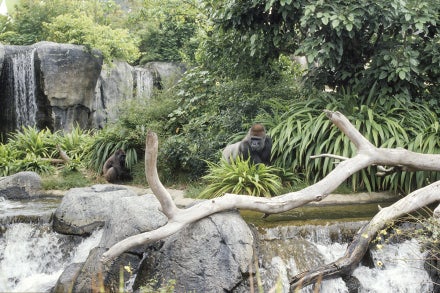
For many botanical species, the time to shine—and blossom—is while basking in the rays of the sun. For other flora, however, it’s the light of the moon that serves as a backdrop as they get up and growing. And while plants need the same things— light, air, water, nutrients, and space—when and how these requirements are met is what sets the after-hour horticultural varieties apart.
Working the Late Shift
One of the main reasons for some plants to have nocturnal tendencies can be traced to adaptations that make the most of available resources, notes Adam Graves, director of horticulture for the San Diego Zoo. “With many night-blooming plants, their pollinators are active at night, so their blooming cycle shifts accordingly,” he explains. “That’s why many nightblooming species are found in the desert—nighttime is when most pollinators are active to avoid the heat of the day.” So while a morning glory’s daytime flowers attract bees and butterflies, its sister, the moonflower—like other night bloomers—plays host to different guests.
“After dark, bats and some moths take over pollinating duties,” says Raj Brown, director of horticulture for the San Diego Zoo Safari Park. Raj adds that night bloomers entice their visitors by appealing to more than one sense. “Not only are nocturnal flowers usually pale or white, which makes them easier for pollinators to see in the dark, some are heavy with fragrance and copious dilute nectar, which are very attractive.” And it’s not just pollinators who are drawn to these flowers— plant aficionados and home gardeners find them irresistible as well. Luckily, both the Zoo and Safari Park have nightblooming floral species on grounds to provide inspiration.

Pollinated by moths, Epidendrum parkinsonianum emits a citrusy fragrance.
Late Bloomers at the San Diego Zoo
Members of the night-blooming cereus group—flowering ceroid cacti that bloom at night—have put down roots at the Zoo. These flowers are short-lived, Adam notes, adding that the blossoms on some of these species, such as the Peruvian apple cactus Cereus repandus, bloom for only one night. Sharing a habitat with legless lizards over by the Reptile House, this species, with its large, cream-colored blooms, is particularly important to pollinating bats. Its thornless fruit ranges in color from violet-red to yellow.
Given its sprawling size and ornate white blossoms, it’s hard to miss the dragon fruit Hylocereus undatus that grows near the Zoo’s Kopje. Its reddish fruit can reach six inches in length.
With their floral-fruity scent, it’s likely the night scented orchids can be smelled before they’re seen. “We have orchids in the collection that emit a strong fragrance in darkness to attract their pollinators,” explains Heinfried Block, senior plant propagator and orchid specialist at the Zoo. “Epidendrum parkinsonianum and lady of the night Brassavola nodosa are prominent examples of night scented orchids in our collection. They do not close their flowers during the day, they just stop producing the strong scent during daylight.” Heinfried adds that the appearance of the flower itself remains unchanged, and, like some other night-blooming plants, the flowers of those orchids pollinated by night hawks not only give off a strong scent, but they are also white in color, thus appealing to the insect’s sense of vision as well as sense of smell.
Intrigued by what goes bloom in the night? Along with the family-friendly fun of HalGLOWeen, October weekends at the San Diego Zoo bring later hours, staying open until 9 p.m. on Fridays, Saturdays, and Sundays.

With regular watering, Datura wrightii will bloom all summer. Its blossoms measure about five inches across.
Blossoming after Dark at the Safari Park
Night-blooming plants have also put down roots at the Safari Park. In the Hidden Jungle Aviary, the angel’s trumpet Brugmansia suaveolens beckons guests—and pollinators—to its branching trunks with a sweet fragrance. This evergreen tree can get up to 30 feet tall when grown outdoors.
The Safari Park’s World Gardens, on the way up to Baja Gardens trail, also contain Peruvian apple cactus. When local bats and moths show up to enjoy some nectar, pollination takes place. After pollination, the flower dies, but the base of its stem grows into a round, sweet fruit with crunchy seeds that, in turn, gives pollinators and various birds something else to eat.
Throughout the Safari Park, sacred datura Datura wrightii catches the eye with its large, dark green-gray velvety leaves. This California native plant is adorned with white flowers that grow to six or seven inches long and five inches wide. Also growing in multiple Safari Park locations is white-fleshed pitaya Selenicereus undatus, a lithophytic cactus (it grows on or around rocks) with sprawling stems. The scented, white, nocturnal flowers can reach up to 14 inches in length and 12 inches in diameter.
There are a lot of night-blooming beauties to see at the Safari Park, and October’s Autumn Festival is all about enjoying the season. Weekend hours (Saturday and Sunday) are extended to 7 p.m., so there’s extra time to see what’s “growing” on.




